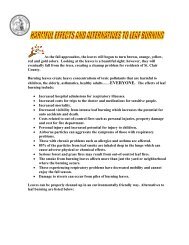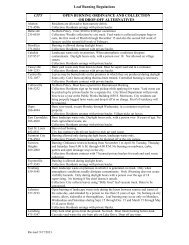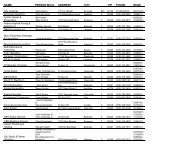FAQ - St. Clair County Health Department
FAQ - St. Clair County Health Department
FAQ - St. Clair County Health Department
Create successful ePaper yourself
Turn your PDF publications into a flip-book with our unique Google optimized e-Paper software.
What do the test results indicate?<br />
If your test results show unacceptable levels of Radon, as the homeowner you can fix the problem<br />
yourself or hire a contractor. All mitigation contractors are licensed by the <strong>St</strong>ate of Illinois and have the<br />
proper equipment, specialized training and technical skills necessary for radon mitigation. For a list of<br />
licensed radon measurement professionals go to http://www.radon.illinois.gov/RadonIllinois.asp and<br />
use the interactive map to click on your county for a list of mitigation contractors.<br />
<strong>FAQ</strong>s for Homeowners/Buyers<br />
Q. What can <strong>St</strong>. <strong>Clair</strong> <strong>County</strong> <strong>Health</strong> <strong>Department</strong> do for radon testing and mitigation in my home?<br />
A. <strong>St</strong>. <strong>Clair</strong> <strong>County</strong> <strong>Health</strong> <strong>Department</strong> can ONLY provide information in regards to testing and mitigation<br />
in the home. <strong>St</strong>. <strong>Clair</strong> <strong>County</strong> <strong>Health</strong> <strong>Department</strong> is not a provider for test kits, testing labs or mitigation<br />
professionals. All information provided is supplied by the Illinois Emergency Management Agency<br />
Division of Nuclear Safety.<br />
Q. What is radon?<br />
A. Radon is a colorless, odorless, naturally occurring, inert radioactive gas that is the only gaseous<br />
element of the long, uranium‐238 radioactive decay chain. Uranium is a common component of soil<br />
around the world.<br />
Q. How do you test for radon?<br />
A. The only way to learn of the presence of radon is to use an instrument or device that is designed to<br />
measure or detect it. (See the DNS Guide to Home Environment Radon Measurements; or if you are in a<br />
real estate transaction, see the DNS Radon Testing Guidelines for Real Estate Transactions.)<br />
Q. I want to test my own house. Where do I place the detectors?<br />
A. The <strong>Department</strong> recommends that residents test like the professionals do. Place two detectors in<br />
each lowest structural area suitable for occupancy. For instance, if your house includes a basement, an<br />
area over a slab, and an area over a crawlspace, TEST in at least one room in each area. The HIGHEST<br />
radon level in your home may not be in your basement.<br />
Q. Where can I buy radon detectors?<br />
A. Radon detectors are available at area hardware and home improvement stores. If you can't find them<br />
there, check the List of Laboratories on our web site at www.illinois.gov/iema/radon/lab.asp<br />
Q. I have a continuous headache, could that be radon?<br />
A. Probably not. There are no early symptoms associated with usual radon exposure. However, your<br />
illness may be an indication that your residence, office, etc. has other indoor air quality problems. The<br />
United <strong>St</strong>ates Environmental Protection Agency (USEPA) has identified at least 27 additional indoor air





